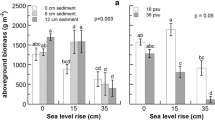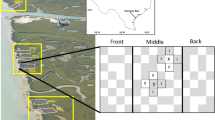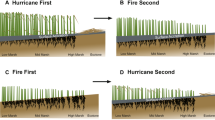Abstract
During the next century coastal marsh sustainability will largely depend on whether or not marshes can keep pace with rising sea levels while weathering more frequent and/or intense storms. In particular, hurricanes have the potential to inflict widespread damage to coastal systems, but can also deliver nourishing inorganic sediment. To determine if hurricane-induced sedimentation can enhance marsh condition and promote marsh sustainability, even in regions of high relative sea level rise (RSLR), we experimentally assessed primary productivity and marsh resilience in marshes that were subject to various levels of hurricane-induced sedimentation in 2005 and 2008 in coastal Louisiana, where RSLR is accelerated due to land subsidence. Primary production and marsh resilience, i.e., recovery rate of plant cover after an experimental disturbance, increased in response to hurricane-induced sedimentation. Sedimentation led to a more oxidized soil environment, reduced porewater sulfide concentrations, and increased porewater phosphorus and exchangeable soil iron and manganese concentrations. Improved soil physicochemical conditions were likely responsible for the increased productivity and resilience, even with the high rates of RSLR the area experiences. This suggests that when storm-induced sedimentation is sufficient, stability of coastal marshes may be enhanced, at least for some time, helping to cope with sea level rise.





Similar content being viewed by others
References
American Public Health Association (APHA) (2005) Standard Methods for the Analysis of Water and Wastewater, twenty-first ed. APHA, Washington, DC
Barras JA (2006) Land area change in coastal Louisiana after the 2005 hurricanes—a series of three maps. U.S. Geological Survey Open File Report 06–1274
Baustian JJ, Mendelssohn IA, Hester MW (2012) Vegetation's importance in regulating surface elevation in a coastal marsh facing elevated rates of sea level rise. Global Change Biology 18:3377–3382
Cahoon DR (2006) A review of major storm impacts on coastal wetland elevations. Estuaries and Coasts 29:889–898
Cahoon DR, Reed DJ, Day JW Jr, Steyer GD, Boumans RM, Lynch JC, McNally D, Latif N (1995) The influence of Hurricane Andrew on sediment distribution in Louisiana coastal marshes. Journal of Coastal Research, SI 21:280–294
Chabreck RH, Palmisano AW (1972) The effects of Hurricane Camille on the marshes of the Mississippi river delta. Abstract volume second National Coastal and Shallow Water research Conference
Church JA, Clark PU, Cazenave A, Gregory JM, Jevrejeva S, Levermann A, Merrifield MA, Milne GA, Nerem RS, Nunn PD, Payne AJ, Pfeffer WT, Stammer D, Unnikrishnan AS (2013) Sea Level Change. In: Stocker TF, Qin D, Plattner GK, Tignor M, Allen SK, Boschung J, Nauels A, Xia Y, Bex V, Midgley PM (eds) Climate Change 2013: The Physical Science Basis. Contribution of Working Group I to the Fifth Assessment Report of the Intergovernmental Panel on Climate Change. Cambridge University Press, Cambridge
Couvillion BR, Barras JA, Steyer GD, Sleavin W, Fischer M, Beck H, Trahan N, Griffin G, Heckman D (2011) Land area change in coastal Louisiana from 1932 to 2010. U.S. Geological Survey Scientific Investigations Map 3164, scale 1:265,000, 1 sheet, 12 p. pamphlet
Croft AL, Leonard LA, Alphin TD, Cahoon LB, Posey MH (2006) The effects of thin layer sand nourishment on tidal marsh processes: Masonboro Island, North Carolina. Estuaries and Coasts 29:737–750
Ford MA, Cahoon DR, Lynch JC (1999) Restoring marsh elevation in a rapidly subsiding salt marsh by thin-layer deposition of dredged material. Ecological Engineering 12:189–205
Gambrell RP, Patrick WH Jr (1978) Chemical and microbiological properties of anaerobic soils and sediments. In: Hook DD, Crawford RM (eds) Plant Life in Anaerobic Environments. Ann Arbor Scientific Publishing, Inc, Ann Arbor, USA, pp 375–423
Graham SA, Mendelssohn IA (2013) Functional assessment of differential sediment slurry applications in a deteriorating brackish marsh. Ecological Engineering 51:264–274
Grimm V, Wissel C (1997) Babel, or the ecological stability discussions: an inventory and analysis of terminology and a guide for avoiding confusion. Oecologia 109:323–334
Holling CS (1996) Engineering resilience versus ecological resilience. In: Schulze P (ed) Engineering Within Ecological Constraints. National Academy Press, Washington DC, pp 31–44
Howes BL, Howarth RW, Teal JM, Valiela I (1981) Oxidation-reduction potentials in a salt marsh: Spatial patterns and interactions with primary production. Limnology and Oceanography 26:350–360
IPCC (2012) Managing the risks of extreme events and disasters to advance climate change adaptation. In: Field CB, Barros V, Stocker TF, Qin D, Dokken DJ, Ebi KL, Mastrandrea MD, Mach KJ, Plattner G-K, Allen SK, Tignor M, Midgley PM (eds) A special report of Working Groups I and II of the Intergovernmental Panel on Climate Change. Cambridge University Press, Cambridge
Kintisch E (2013) Can coastal marshes rise above it all? Science 341:480–481. doi:10.1126/science.341.6145.480
Kirwan ML, Guntenspergen GR, D’Alpaos A, Morris JT, Mudd SM, Temmerman S (2010) Limits on the adaptability of coastal marshes to rising sea level. Geophysical Research Letters 37. doi:10.1029/2010GL045489
Koch MS, Mendelssohn IA (1989) Sulphide as a soil phytotoxin: differential responses in two marsh species. Journal of Ecology 77:565–578
Kolker AS, Allison MA, Hameed S (2011) An evaluation of subsidence rates and sea-level variability in the northern Gulf of Mexico. Geophysical Research Letters 38. doi:10.1029/2011GL049458
La Peyre MK, Grossman B, Piazza BP (2009) Short- and long-term response of deteriorating brackish marshes and open-water ponds to sediment enhancement by thin-layer Dredge disposal. Estuaries and Coasts 32:390–402
Lamers LP, Govers LL, Janssen IC, Geurts JJ, Van der Welle ME, Van Katwijk MM, Van der Heide T, Roelofs JG, Smolders AJ (2013) Sulfide as a soil phytotoxin-a review. Frontiers in Plant Science 4:268. doi:10.3389/fpls.2013.00268
Lindsay WL, Norvell WA (1978) Development of a DTPA soil test for zink, iron, manganese, and copper. Soil Science Society of America 42:421–428
McKee KL, Cherry JA (2009) Hurricane Katrina sediment slowed elevation loss in subsiding brackish marshes of the Mississippi River Delta. Wetlands 29:2–15
McKee KL, Mendelssohn IA, Hester MW (1988) Reexamination of pore water sulfide concentrations and redox potentials near the aerial roots of Rhizophora mangle and Avicennia germinans. American Journal of Botany 75:1352–1359
Mendelssohn IA, Kuhn NL (2003) Sediment subsidy: effects on soil plant responses in a rapidly submerging coastal salt marsh. Ecological Engineering 21:115–128
Morgan JP, Nichols LG, Wright M (1958) Morphological Effect of Hurricane Audrey on the Louisiana Coast Contribution no. 58–3, Coastal Studies Institute, Louisiana State University, Baton Rouge, LA
Morton RA, Barras JA (2011) Hurricane impacts on coastal wetlands: A half-century of storm-generated features from Southern Louisiana. Journal of Coastal Research 27:27–43
Nicholls RJ, Hoozemans F, Marchand M (1999) Increasing flood risk and wetland losses due to global sea-level rise: regional and global analyses. Global Environmental Change 9:S69–S87
NOAA (2010) Tides and Currents, Mean Sea Level Trend 8761724 Grand Isle, Louisiana. Available at: http://www.tidesandcurrents.noaa.gov/sltrends Accessed 8 December 2014
Nyman JA, Crozier CR, DeLaune RD (1995) Roles and patterns of hurricane sedimentation in an estuarine marsh landscape. Estuarine, Coastal and Shelf Science 40:665–679
Patrick WH, Gambrell RP, Faulkner SP (1996) Redox measurements of soils. In: Bartels JM, Bigham JM (eds) Methods of soil analysis, vol 3, Part. Chemical methods. Soil Science Society of America and American Society of Agronomy, Madison, pp 1255–1271
Rybczyk JM, Cahoon DR (2002) Estimating the potential for submergence for two wetlands in the Mississippi River delta. Estuaries 25:985–998
Shinkle KD, Dokka RK (2004) Rates of vertical displacement at benchmarks in the lower Mississippi Valley and the northern Gulf Coast. NOAA Technical Report NOS/NGS 50, 135 pp
Slocum MG, Mendelssohn IA (2008) Use of experimental disturbances to assess resilience along a known stress gradient. Ecological Indicators 8:181–190
Slocum MG, Mendelssohn IA, Kuhn NL (2005) Effects of sediment slurry enrichment on salt marsh rehabilitation: plant and soil responses over seven years. Estuaries 28:519–528
Smalley AE (1958) The role of two invertebrate populations, Littorina irrorata and Orchelium fificinium, in the energy flow of a salt marsh ecosystem. Dissertation, University of Georgia
Stagg CL, Mendelssohn IA (2010) Restoring ecological function to a submerged salt marsh. Restoration Ecology 18:10–17
Stagg CL, Mendelssohn IA (2011) Controls on resilience and stability in a sediment-subsidized salt marsh. Ecological Applications 21:1731–1744
Thomas GW (1982) Exchangeable cations. In: Page AL, Miller RH, Keeney DR (eds) Methods of soil analysis. Part 2. Chemical and microbiological properties, 2nd edn. Soil Science Society of America and American Society of Agronomy, Madison, pp 159–165
Trenberth K (2005) Uncertainty in hurricanes and global warming. Science 308:1753–1754
Turner RE, Baustian JJ, Swenson EM, Spicer JS (2006) Wetland sedimentation from Hurricanes Katrina and Rita. Science 314:449–452
Turner RE, Swenson EM, Milan CS, Lee JM (2007) Hurricane signals in salt marsh sediments: Inorganic sources and soil volume. Limnology and Oceanography 52:1231–1238
Acknowledgements
This study was funded by grants from the United States Department of Energy’s National Institute for Climate Change - Coastal Center. Field and laboratory assistance was provided by Sean Graham, Carey Perry, and Allison Music. We would also like to thank two anonymous reviewers who provided comments to improve this manuscript.
Author information
Authors and Affiliations
Corresponding author
Rights and permissions
About this article
Cite this article
Baustian, J.J., Mendelssohn, I.A. Hurricane-Induced Sedimentation Improves Marsh Resilience and Vegetation Vigor under High Rates of Relative Sea Level Rise. Wetlands 35, 795–802 (2015). https://doi.org/10.1007/s13157-015-0670-2
Received:
Accepted:
Published:
Issue Date:
DOI: https://doi.org/10.1007/s13157-015-0670-2




